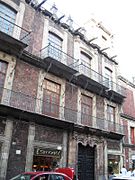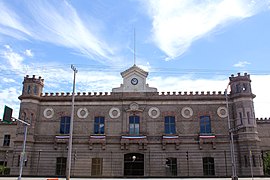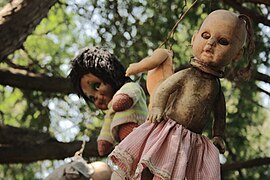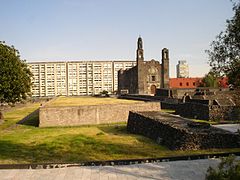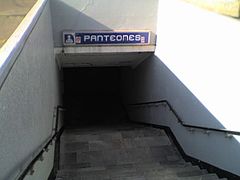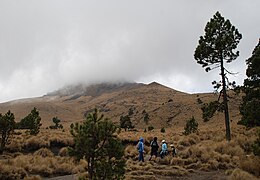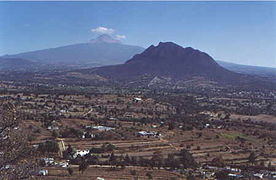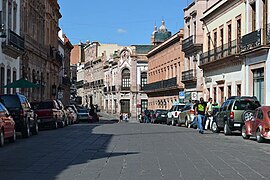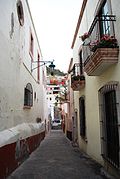List of reportedly haunted locations in Mexico
 From Wikipedia - Reading time: 43 min
From Wikipedia - Reading time: 43 min
The following is a list of reportedly haunted locations in Mexico.
Aguascalientes
[edit]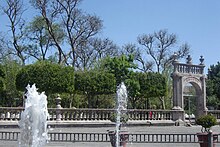
- Garden of San Marcos in Aguascalientes City: park founded in 1847 that annually houses the San Marcos Fair. According to the legend, it is haunted by a male ghost who prays every night at the churches' doors on the park.[1] This is the spirit of a 19th-century man named Felipe Rey González, who hid his treasure in the garden. He died before telling anyone where it was, and supposedly, this circumstance turned him into a ghost.[2]
Baja California
[edit]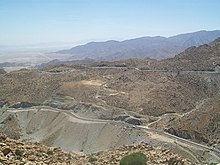
- Agua Caliente Casino and Hotel in Tijuana: a former casino, now a high school, which is allegedly haunted by a female singer who poisoned her lover after stealing money from him in the 1930s. According to legend, the man pursued her in an attempt to get the antidote, but she refused to give it to him, and he shot her to death in frustration.[3]
- La Rumorosa Highway: is a famous and heavily traveled road that crosses the Sierra de Juárez Mountains in Baja California. From the 1950s through today, truck drivers and travelers report encounters with phantom hitchhikers, demon children, shadow people and alien-like creatures.[4]
Baja California Sur
[edit]- Colegio Salvatierra in Santa Rosalía, Baja California Sur: according to legend, there was a student, a small child, who used to play with marbles in the girls' bathroom. One day he accidentally swallowed a marble, which choked him to death. After teachers took out the body, girls who enter the bathroom have said that they heard noises of laughter and a child playing with marbles, and some have said they have seen marbles roll into the bathhouses.[5]
- Hotel California in Todos los Santos, Baja California Sur: founded in 1948; several entities supposedly haunted the inn's courtyard.[6]
- Hotel Finnestera in Cabo San Lucas: the ghost of a maid as well as voices are allegedly encountered.[3]
- Biblioteca Estatal Justo Sierra in La Paz: founded in 1918; during its history the building was a prison, a hospital and an orphanage. Allegedly a little girl haunts it; other phenomena reported here are voices, cries and dark profiles moving.[7][8]
- Panteón Zacatal in La Paz: built on the grounds of an ancient plantation, allegedly several entities haunt it; one of these is the plantation's old owner, Manuel Sandoval. [9] [10]
Chihuahua
[edit]- Chihuahua, Chihuahua: a mansion built from 1888 to 1893; supposedly at least five ghosts inhabit it. The former and the most active is a boy, who usually appears playing with a blue ball on the staircase; according to the legend he was the son of the first house owner, General Luis Terrazas. Other spirits are a little girl, a little boy with a sailor suit, a lady of white and a lady of black. Currently, the building operates as a restaurant.[11][12]
- La Popular Store in Chihuahua, Chihuahua: a wedding boutique which is home to a mannequin that is allegedly an embalmed corpse. According to many witnesses, it moves, blinks and sometimes walks on its own. The story dates back to the 1930s. The mannequin is known as "Pascualita", or "Chonita". According to the legend, a bride was bitten by a spider or scorpion on the day before her wedding, causing her death. The bereft mother (who is the one named "Pascualita"), saddened beyond consolation, hired the best funerary services money could buy and had her daughter embalmed, dressed in the wedding gown, and later displayed the corpse, passing it off as a mannequin. Some versions claim that it was her fiancé that had her embalmed. It is common for late-night taxi drivers to notice the mannequin take life, as the bride's intended was a taxi driver himself. In 2017, the mannequin was taken out of the wedding boutique for the first time and displayed in Mexico City, Mexico as part of Hotel de Leyendas Victoria tour.[13]
Durango
[edit]
- Mapimí Silent Zone in Bolsón de Mapimí, Durango: a legendary site of paranormal phenomena; allegedly orbs and a tall blond man appear on the site. There are also several alleged ufological phenomena such as UFOs and alien-like creatures reportedly spotted on the site.[14]
- Ojuela in Mapimí: a ghost town founded in the 1590s and abandoned in 1928 after a flood, it is considered one of the scariest towns in Mexico particularly for its proximity to Mapimí Silent Zone.[15][16][17]
Guanajuato
[edit]- Callejón del Beso ('The Kiss Alley') in Guanajuato, Guanajuato: allegedly haunted by two lovers who died in tragic circumstances here.[18][19]
- Casa de la tía Aura ('House of Aunt Aura') in Guanajuato, Guanajuato: built in 1805. During the 1840s, two women were murdered in the property by their own father, the first daughter was walled in the basement when he found out that she got pregnant without being married and the second was poisoned afterwards so he could inherit everything. People say that they can hear voices and see orbs and shadows in the house. The house is now a museum.[20]
- Casa de las Brujas, or the House of the Witches, in Guanajuato, was built in 1845 and was owned by a Dutch mine owner by the name of Juan Carson. He was imprisoned for murder, and his daughter, Susan, was left in the custody of her aunts in the house. She was supposedly found beaten and starved to death in the cellar a year later. According to legend, Susan's ghost is said to haunt the house, and odd sounds and cold spots have been reported.[3]
- Casa de Sierra Nevada Hotel in San Miguel de Allende, Guanajuato: allegedly, in this colonial building, the spirits of a 1910s butler and a 19th-century little girl appear. The first is said to often interact with people and a coffee aroma is associated with his presence; the second ghost often wanders in the gardens.[21]
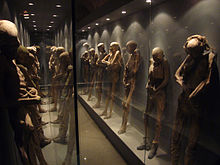
- Castillo de Santa Cecilia Hotel in Guanajuato, Guanajuato: founded in 1686, during its history the building was a plantation and a hospital; it was opened as a hotel in 1951.[22] Several paranormal phenomena are reported in the hotel such as crosses made of oil that appear in the rooms' windows, inexplicable sounds and objects that move on their own.[23]
- Hotel San Diego in Guanajuato: according to a legend, there is a room on the hotel's top floor where the sounds of doors slamming and furniture moving around can be heard.[3]
- House of Laments or Casa de los Lamentos in Guanajuato, Guanajuato: this mansion was the house of a serial killer active from the 1890s to the 1910s named Tadeo Fulgencío Mejía. According to the legend, his victims' crying can be heard in the mansion.[24]
- House of Mummies in Guanajuato, Guanajuato: a museum where the natural mummies of Santa Paula cemetery are on exhibition. Paranormal phenomena have been reported such as the apparition of a tall woman, cries of babies and strange whispering sounds.[25]
- Mineral de Pozos in San Luis de la Paz, Guanajuato: a ghost town from 1920; allegedly miners who died during a flood haunt the mines around the city.[26]
Jalisco
[edit]
- Guadalajara Cathedral in Guadalajara, Jalisco: built in 1618, this church keeps the remains of a 1700s little girl who was stabbed to death by her own father; he disapproved of his daughter's interest in Catholicism and was enraged when he found out that she received the Eucharist without his permission, leading him to murder her. Known as Holy Innocence (Spanish: Santa Inocencia), the mummified body reportedly moves by itself, her hair and nails still grow, and there is a video where she appears to blink.[27]
- Panteón de Belén (Belen Cemetery): located in the center of Guadalajara, it was opened in 1848. According to local legend several entities appear here and many mysteries surround the cemetery, including the "Vampire Tree" and the very visited tomb of "Nachito".[28]
- Clover Lawn House or Casa del Trébol Negro in Guadalajara, Jalisco: built in 1908. Reputed to be haunted by a father who murdered his wife and daughter in the house. Supposedly, the ghosts wander throughout the property; bloody marks appear in the room walls; crying, shouting and voices are heard in the house.[29][30]

- Hospicio Cabañas in Guadalajara, Jalisco: built from 1805 to 1810, during the building's history it was an asylum, military barrack, prison and orphanage. According to legend, several ghosts haunt it, mainly spirit children who wander in the building. Also supposedly it had a monumental clock installed in 1952. The clock mysteriously stopped whenever a child died in the orphanage.[31][32]
- Hospital Fray Antonio Alcalde y Barriga in Guadalajara: opened in 1788 and still in operation. Supposedly, several paranormal entities appear in the hospital; the most active is a 19th-century female nurse named Manuela Lozano, who wanders the Internal Medicine wing.[33][34]
- Journalism Museum, also known as La Casa de los Perros or The House of the Dogs: located in the center of Guadalajara, it is a colonial mansion that in the 1790s housed the first independent newspaper of America. The hauntings are attributed to the original owner's wife, who took on a lover and later conspired to kill her husband.[35][36]
- Palacio de las Vacas (Cows Palace) in Guadalajara, Jalisco: a Porfirian mansion built between 1890 and 1910; it was the property of dictator Porfirio Diaz and his family, a women's college, a kindergarten and perhaps a brothel; it was also abandoned for many years. Allegedly, it is haunted by various spirits, such as a schoolgirl who committed suicide. Phenomena reported include children's voices, screams, and shadows.[37][38]
Mexico City
[edit]- Mexico City International Airport in Venustiano Carranza, Mexico City: allegedly haunted by a little girl who often appears to be playing with a ball and interacts with people. She asks them to tie her shoelace then disappears. Supposedly the ghost was filmed and the video can be seen on YouTube.[39] Also, in 2016, a patrolman reported seeing a ghost in the back of an airplane and recorded it on his phone.
- Bamer Building in the Historic center of Mexico City: founded in 1953 and was a hotel until the 1990s.[40] Several paranormal phenomena are reported in the building, including bizarre sounds, pommels that emit electric discharge and the apparitions of a little girl.[41][42]
- Callejón del Aguacate in Coyoacán, Mexico City: the site of esoteric rituals;[43] according to testimony, an entity wanders through this backstreet.[44]
- Casa de la tía Toña ('Aunt Toña's House') in Chapultepec, Mexico City: several fatal accidents were reported on the property. Also, according to the legend, the first owner, a woman, and her adopted children died in the mansion and then haunted it.[45]
- Casa de las Brujas or the Rio de Janeiro building in Colonia Roma, Mexico City: was built in 1908. During the first part of the 20th century, a woman named Bárbara Guerrero, also known as "Pachita", lived there. The legend says that she practiced witchcraft; supposedly several paranormal phenomena occur in the house including the appearance of the ghost of Guerrero.[46][47]
- Casa de los Condes de la Torre Cossío y de la Cortina, or the House of the Count De la Torre y la Cortina, in the Historic center of Mexico City: a colonial mansion, in which a spree killer named Juan Manuel de Solórzano lived in the 1630s. Believing his wife was capable of cheating on him, he killed several men, simply because they walked outside his house. Solórzano would ask them the time; if they responded 11 PM , or showed anxiety, he would stab them. He was executed in 1641.[48] The legend says that a man with 1600s-era clothing wanders in and around the house, sometimes asking bystanders for the time, and soon after doing so, disappearing.[49]
- Casa Negra ('Black House') in Álvaro Obregón, D.F.: a 19th-century mansion, now abandoned. According to the legend, its first owners – a family named Mondragón – died of unknown causes in the house; without a live heir, the property passed into state custody. Supposedly, because of the paranormal phenomena, the house is uninhabitable. Paranormal activity on the site includes temperature changes, voices, bizarre sounds, doors opening and closing by themselves, and invisible hands that regularly touch and pull people.[50]
- Fru Fru Theater: A late 19th century theater located in Donceles street. Due to its extensive and controversial history, the Fru Fru theater is the setting for several paranormal legends. One of the most talked about is “El Catrín”, the spirit of a wealthy man who allegedly curses the plays.[51]
- Hospital Juarez in Gustavo A. Madero, Mexico City: opened in 1847 and still functioning. Here started one of the most famous Mexican ghost stories: the legend of La Planchada, a spirit of an early 20th-century female nurse who haunts the hospital.[52] This ghost has also been seen in several other hospitals around Mexico.
- Instituto Cultural La Moira in San Miguel Chapultepec, Miguel Hidalgo, D.F.: according to legend this house is haunted by several paranormal entities; the most active is a young man named Marcos who died under mysterious circumstances during the 1960s. Allegedly when he was an eight-year-old boy, he entered the then-abandoned building and saw an apparition, a man hanged in one of the rooms. 10 years after the incident, he hanged himself in the same room in an apparent suicide. Several spiritism sessions have been held at the site since. Paranormal phenomena reported in the house include shadows, strange sounds, orbs, and objects moving by themselves. Some people say they have had visions and demonic possessions. According to some parapsychologists, this house is the most haunted in Mexico.[53][54][55]
- La Malinche's house in Coyoacán, Mexico City: a 16th-century mansion that is reputed to be haunted by several ghosts,[56] principally the ghost of La Malinche.[57]
- Mexico City Metro: opened to the public in 1969, several entities haunted its installations, mainly people who committed suicide. According to the legend, the Tasqueña station is one of the most haunted places in the train network. Supposedly, an old man appears at night to keep lonely passengers company. The man was murdered while sitting alone during an assault and for this reason he wants to protect people. Other haunted stations are the Pino Suárez station where an old employee named Victor Castilla Platonoff died on-site in 1989 and apparently does not know that he has died. There have also been reports of colonial monks chanting and ancient Aztec ghosts,[58] including a man who cries because the Spanish Conquest;[59] time traveling and interdimensional portals,[60] the Panteones station where people say that they can hear knocks in the tunnel walls that connect the station with the next one and shadow "lumps" a few feet ahead that disappear as they get close – the paranormal activities in this place are attributed to its proximity to two old graveyards, the Spanish and British graveyards;[61][62] the Airport station where a little girl appears to be playing with her own severed head; and the Viaducto station where in 1975 the worst subway accident in Mexico City's history occurred with at least 31 deaths – supposedly since then a ghost train runs from Allende station to Zócalo station, the same route as the ill-fated train.[63]
- Palace of the Inquisition in the Historic center of Mexico City: built between 1732 and 1736, it was the place of the New Spain Tribunal of the Holy Inquisition until 1820 when it was disbanded. Supposedly, the building is home to several paranormal entities.[64][65]
- Palacio de Lecumberri in Venustiano Carranza, Mexico City: built in 1900, it served as a prison for 76 years.[66] Supposedly several entities live in the building, but two are the most active. The first is a male spirit, which wanders throughout the building, wanting to interact with people. Reportedly, he would say "My name's Jacinto" or "Again, Amalia didn't come here" and disappear.[67] The second is also a male spirit, dressed in a black charro costume, who is especially aggressive, and has appeared to many people.[68]
- Panteón de San Isidro in Azcapotzalco, Mexico City: a cemetery exclusively for children; according to legend several entities appear at the site but two are the most active – the first is a little girl named Nani who appears in a street next to the cemetery, causing car accidents because she often distracts the drivers. The second is a boy named David who often interacts with people.[69]
- Plaza de las Tres Culturas or Plaza de Tlatelolco in Cuauhtémoc, Mexico City: the history of location dates to before the 15th century; at this time several tragic events took place. In the Pre-Columbian era, it was the most important market in Mesoamerica but was also a public execution place.[70] During the Spanish conquest of Mexico several Indigenous Mexicans were mass murdered here, resulting in 4,000 deaths on August 13, 1521. Contemporary bloody events such as the Tlatelolco massacre in 1968 and the Nuevo León building collapse during 1985 Mexico City earthquake, with at least 400 fatalities, also occurred here.[71] Stories of ghosts in this place are told from the time of the Aztecs.[72] The paranormal phenomena reported are sounds of children playing, the sounds of the 1968 massacre[73] and shadows moving from the Foreign Relations building to the church.[74]
- Posada del Sol in Colonia Doctores, Mexico City: an ambitious inn project during the 1950s. Due to several mishaps it was never completed. Finally, the owner, Fernando Saldaña, committed suicide on the site in 1945. According to legend, he cursed the property for it will be never inhabited. After Saldaña's death, the building became a home to the Instituto Indigenista Americano, El Consejo de Recursos Minerales and the Procuraduría General de Justicia, but it was always abandoned. Allegedly, the ghost of Saldaña still haunts the lonely building.[75]
- Swamp South of Mexico City: the Island of Dolls is rumoured to be one of the most haunted sites in Mexico. Don Julian Santana was a man who lived as a hermit on the island for over fifty years, where he is believed to have lost his mind. The tragic accident of a girl who drowned on the island while visiting caused further madness in Julian. The island was turned into a shrine for the little girl. Dolls hang in the trees and the house. Each of the dolls is believed to be fused with the energy of the little girl. Candles, hard candy, and dolls are occasionally brought as offerings to appease the spirits. The dolls are said to move, beckon, and speak to those who come. The man's spectre also roams this place. Orbs, loud sounds, and reports of doll eyes opening abound.[3]
- Templo Mayor Museum in the Historic center of Mexico City: an archaeological site corresponding to the ruins of ancient Aztec temples dedicated to the gods Huitzilopochtli, Tlaloc and others; nearly 4,000 people were murdered there during human sacrifices.[76] Allegedly paranormal activities reported include shadows, cries, voices and strange sensations.[77]
- XEW-AM radio station in Coyoacán, Mexico City: allegedly haunted by several ghosts including the spirits of Agustín Lara, Pedro Infante, Jorge Negrete and Alfonso Ortiz Tirado; the paranormal phenomenona reported here are voices, objects moving by themselves and even the music of Agustin Lara's piano or his singing, also Negrete, Infante or Ortiz singing.[78][79]
- Haunted places in Mexico City
-
Casa de los Condes de la Torre Cossío y de la Cortina.
-
Palace of Inquisition.
-
Palacio de Lecumberri.
-
Dolls in the Xochimilco Dolls′ Island.
-
Plaza de las Tres Culturas, Tlatelolco.
-
Entrance to Panteones station subway.
-
La Malinche's house.
-
Templo Mayor ruins.
Michoacán
[edit]- Lago de Camécuaro National Park in Zamora de Hidalgo: according to legend, the lake is haunted by a Purépecha princess named Huanita. Allegedly, she materializes completely as a beautiful woman in front of people; when she does, she appears to be crying and sometimes tries pulling the legs of people swimming in the lake with the intention of drowning them so that they will be with her forever.[80]
Nuevo León
[edit]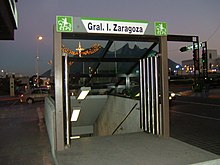
- Casa de Aramberri in Monterrey: reputed to be haunted by a man's wife and daughter, who, according to legend, were tortured to death by three male robbers in 1933.[3]
- Casa de los Tubos in Monterrey, Nuevo Leon: an abandoned mansion built during the 1970s, reputed to be haunted by a girl who committed suicide on the property and a boy that died in an accident.[81]
- Villa de Santiago, Puerto Genovevo: these mountainous roads have been the site of many car accidents. Among the numerous crosses, there is a set of ten crosses in memory of a family who were the victims of a truck accident. If one stands next to the crosses, it is rumored to be possible to see a truck moving very fast through the trees. Also, it is said that at midnight the screams and pain of those in the accident can be heard.[3]
- Zaragoza metro station in Monterrey, Nuevo Leon: allegedly, the cries of a ghostly boy can be heard inside of the station; he is heard calling for his dad in a desperate manner.[82][83]
Oaxaca
[edit]
- Historic Center of Oaxaca in Oaxaca City, Oaxaca: this World Heritage Site has many legends; one of the most famous is the legend of Matlazihua or Matlacihua, an evil entity who appears in the form of a beautiful Native American woman dressed in a large white transparent dress. She often seduces men, who she then leads to solitary places (such as an alley) where she kills them. She prefers machists and drunk men. According to some versions she is an incarnation of the Aztec goddess Mictlantecihuát, and according to others she is the ghost of an Indigenous Mexican woman who was raped and murdered during colonization and now seeks revenge.[84][85][86][87]
- Jarquin in Mietchulan, Oaxaca: this small store is haunted by its anonymous former owner. The owner's apparition is known to walk in and out of the building. He is notorious for pushing customers out of the store.[88]
Puebla
[edit]- Chautla Hacienda in Puebla, Puebla: opened in 1777, it was an agave plantation and currently is an inn. Allegedly this site is haunted by several entities; the ghosts of a horseman and a boy were filmed on the site.[89]
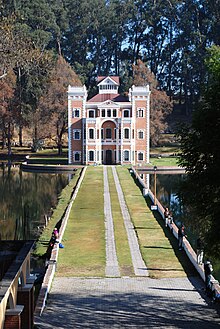
- Instituto Cultural Poblano in Puebla, Puebla: built from 1740 to 1751, it was a Society of Jesus convent to 1767. After serving as a cemetery during the Typhus epidemic of 1812–1813, the property was used as a prison from 1841–1870 and the Penitentiary of Puebla operated until 1984, when it became a cultural center and museum.[90] Allegedly the building is haunted by many ghosts of different shapes.[91][92]
- Santa Mónica Religious Art Museum in Puebla, Puebla: built in 1606 as a poorhouse and orphanage. From 1686 to 1934, it served as an Augustinian Recollects convent.[93] The religious abandoned the building by state order after a scandal when the conditions of cloister life were discovered.[94] According to legend the former convent is the site of several paranormal events such as apparitions of a woman in white,[95] apparitions of people wearing antique clothing who are seen wandering the installations, or the sound of nonexistent clocks.
- San Pedro Art Museum in Puebla, Puebla: formerly a hospital, government offices and a sports court, it is allegedly haunted by the ghosts of people buried under its courtyard when it was a hospital. Reports include the ghosts of a revolutionary soldier, people in old-fashioned clothes, and a little girl playing with a ball.[96]
Querétaro
[edit]- Casa de La Zacatecana: a colonial mansion in Santiago de Querétaro, Querétaro. In the 17th century, a woman known as "La Zacatecana" commanded the murder of her husband, and then executed the killer she hired for the murder herself. The legend says that the mansion harbours three spirits.[97]
- Capilla de las Benditas Ánimas del Purgatorio in Colón, Querétaro: a Roman Catholic church founded with the objective of practicing exorcisms, the only one of its kind in the country.[98][99][100]
- Claudia Mijangos house: located in a suburb of Querétaro, and where Claudia Mijangos killed her three children in 1989. She said that "... she was possessed by a demonic entity". To this day, neighbors claim that they can hear crying and shouting in the house and a boy appears in a window on the second level. The local government boarded the windows and built a wall around the house to deter vandalism and the curious public. Although the house is legally granted to Claudia Mijangos, it remains abandoned and unclaimed since her release in 2019. The home was subject of investigation by the Mexican paranormal television program, Extranormal.[101]
Quintana Roo
[edit]- Jungles of Quintana Roo: according to local legend, an evil entity known as Juan del Monte lives among the state jungles. This entity often imitates familiar human voices to attract visitors and cause them to get lost in the jungle.[102][103] The legend of Juan del Monte originated in Native American folklore and is also told in other Mexican states such as Veracruz or Puebla. Other versions of the Juan del Monte legend paint the entity as a neutral entity who serves as a nature guardian.[104]
San Luis Potosí
[edit]- Cerro de San Pedro in Cerro de San Pedro, San Luis Potosí: a ghost town, which is allegedly haunted by a Guachichil boy who often interacts with people and tries to get them to enter one of the mines by offering them three golden oranges.[105]
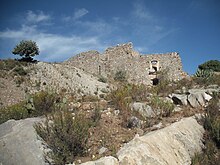
- La Joya Honda in Soledad de Graciano Sánchez, San Luis Potosí: a 800m wide and 200m deep crater. According to legend, a group of bandits hid their treasure during the 1910s and their ghosts still watch over it. Other alleged paranormal phenomena reported are ghost witches and UFO sightings – allegedly, the Witches' Sabbath was often celebrated there in the past.[106]
- Real de Catorce in Sierra de Catorce, San Luis Potosí: a ghost town founded in 1770 and abandoned in 1920;[107] supposedly the town is haunted. According to legend one of the most active ghosts is an ancient miner known as "El Jergas", a benevolent entity who guides miners to new silver veins.[108]
Sinaloa
[edit]- Hospital General de Culiacán in Culiacán, Sinaloa: allegedly haunted by a nun and also by the ghost of La Planchada.[109]
Sonora
[edit]- Los Estralios Mines in San Carlos Nuevo Guaymas, Guaymas: alleged to be inhabited by a demon or a werewolf called "Neuale".[110]
State of Mexico
[edit]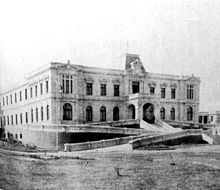
- Lake Texcoco in Texcoco, State of Mexico: a murderous monster was said to live in the depths of this lake. The name of the beast is Ahuizotl. It was a canine mammal with spiky hair and a hand at the tip of its long tail. It ate humans. In order to attract people, it would produce a sound similar to that of an abandoned human baby crying. Its victims were caught by it and then were drowned in the lake. In Aztec mythology the souls of its victims were sent to Tlalocan.[111][112][113]
- Lerma Marshes in San Miguel Almaya: a mermaid is said to live in the lakes and swamps. Her name is Tlanchana. She comes out of the marshes once or twice a year. She is beautiful and attractive. If a man follows her, he dies.[114][115]
- Pilar Hacienda in San Juan Teotihuacán: built by the Spaniards who came to Mexico in the 16th century. On the top floor there is a large scratch on the window, which is believed to be the mark of Miguel Aritztia, a Spanish hidalgo. It is thought that he died from falling off the balcony, and before he fell he held on to the window, creating the long scratch. The ghost of Aritztia's wife has also been seen on the balcony crying "Oh, my husband." (in Spanish: Oh, mi esposo), She was there at the time of his death and tried to save him. Aritztia has been reported to be seen hanging from the window, as well as being seen in a window. It is said that at times the scratch disappears from the window.[116]
- Asilo General La Castañeda or La Castañeda Psychiatric Hospital only exists in the central building in Amecameca: it was the biggest insane asylum in Mexico, opened in Mexico City during 1910; it was active for 58 years and during this time is said to have housed around 60,000 patients. Several paranormal cases have been reported in the hospital.[117]
Tlaxcala
[edit]- Matlalcueitl volcano and Cuatlapanga mount in La Malinche National Park: supposedly, a reptilian monster who lived on the Matlalcueitl mountain would come down during the rainy season to abduct children and take them up the mountain to be devoured.[118] Other legends say that in Cualtlapanga, the sounds of a golden bell hidden there during the Mexican War of Independence were heard. Many people looked for it but no one found it.[119]
- Haunted mounts in La Malinche National Park
-
Matlalcueitl or Malinche volcano
-
Cuatlapanga mount.
- Posada San Francisco Hotel in Tlaxcala City, Tlaxcala: a 16th-century inn, where according to local legend, the ghost of a little girl ghost who runs to different gardens searching for her mother can be seen. Voices and strange sounds are also reported there.[120][121]
Veracruz
[edit]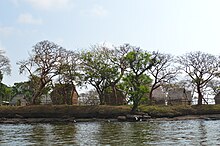
- Catemaco in Catemaco Municipality, Veracruz: internationally known as the "Wizard Capital", the history of the city dates from the 17th century. Each March, from 1774, the city celebrates Witches' Day, when practitioners and believers in witchcraft gather to practice ancient rituals.[122][123] Several legends are told about the site, such as the legend of Cerro del Mono Blanco (White Monkey Mountain) where supposedly a man named Gonzalo Aguirre Pech, known as the "Great Wizard", sold his soul to the Devil.[124]
Yucatán
[edit]- Cecilio Chi Elementary School in Espita, Yucatán: according to a legend, there was a farmer who was a powerful warlock. He was able to obtain any vegetables or fruit from his farm regardless of the time of the year. Furthermore, he could get them in one day, which is not enough time for crops or trees to grow. It was rumoured that he was able to transform into a sinister flying monster known as the Uay Pop. After the suspected shapeshifter died it was said that the Uay Pop haunted the same place where the farm was located.[125]
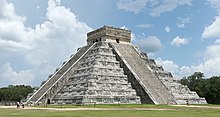
- Chichen Itza in Tinúm, Yucatán: an ancient Mayan city; according to some testimonies, the site is haunted by several entities, from ancient ghosts of sacrificed people[126] and Aluxes – fairy-like spirits in Mayan folklore[127] – to aliens.[128]
- Cholul Hacienda in Mérida, Yucatán: a 19th-century henequen plantation which is now abandoned. According to legend several ancient owners of the plantation practiced witchcraft and Satanism, one of them in the form of an owl[129] Other apparitions included were human shadows in the windows, a woman with a baby crying[130] and an old plantation laborer who committed suicide after killing his fiancée's rapist.[131]
- Hospital Peninsular in Merida, Yucatan: a hospital that operated as an illegal abortion clinic until 2009, when it was closed. According to popular testimonies alleged paranormal events reported on the site occurred in 2007, when the hospital was partially abandoned. A group of policemen entered it one night and said they heard babies crying. Their flashlights stopped working and some doors opened and closed by themselves.[132]
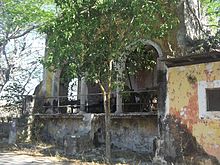
- Misnebalam Hacienda and Village in Progreso, Yucatan: an abandoned 19th-century henequen plantation, it was a village of about 2000 people. Supposedly, witchcraft and public executions were common there. The most active ghost in the property is a boy named Julian who committed suicide after being raped during the 1920s.[133][134] Legend also says a few Mexican folklore demons can be seen, such as the Xtabay and chaneque.[135]
- Wyndham Mérida's Inn in Mérida, Yucatan: allegedly several entities haunted the building. According to employee testimonies, the most active entity is an old man who supposedly was buried under the property before the inn's construction.[136]
Zacatecas
[edit]- Meson de Jobito Hotel in Zacatecas, Zacatecas: built in 1700, and transformed into an inn during the 1940s, it was adapted into condominiums. From 1990 to 1993, the building was transformed into what now is the current hotel.[137] Supposedly the hotel is one of the most haunted places in the country. Reported paranormal phenomena on the site included the feeling of being observed, children's voices and laughter, the same invisible children jumping on the beds, the sounds of horses and objects moving by themselves. This paranormal activity is concentrated in room 107.[138][139][140]
- Historic Center of Zacatecas in Zacatecas, Zacatecas: this World Heritage Site has many legends. One of the most popular is the legend of Calle De Las Tres Cruces, where in 1761 two lovers— named Gabriel García and Beatriz Moncada— died in tragic circumstances. The legend says that the lover's ghosts appear on this street.[141] Calle De Las Tres Cruces is on Hidalgo Avenue where it ends with Toledo Street.[142] Another legend speaks of a haunted backstreet named Callejón del Indio Triste where Xolotl, one of the last leaders of the Chichimeca natives, died in the 1550s.[143] Another alleged haunted backstreet is known as Callejón del Mono Prieto, where according to legend, in the 17th century a woman named Marciana Castillo died there. People believed that she practiced witchcraft and that she was responsible for a child's disappearance and the death of the same child's mother, and therefore she lived alone during her last days; she was burned alive when her house caught fire.[144]
- Haunted places in Zacatecas, Zacatecas
-
Hidalgo Avenue
-
Callejón del indio triste
- Pateón Museo de Dolores in Jerez, Zacatecas: opened in 1809.[145] Many legends are recounted about the cemetery such as the apparition of a man named Juan Juárez "el Melcocha",[146] who was the first person buried here, and the paranormal phenomena associated with a paid mourning statue[clarification needed] that allegedly moves and cries.[147]
See also
[edit]References
[edit]- ^ "Garden of San Marcos, one of the best things to do in Aguascalientes, | Experts in Mexico". zonaturistica.com. Directorio de Hoteles Mexico S.A. de C.V. Retrieved 2019-02-22.
Built in 1847 and located in the Old Town of San Marcos, it is one of the most emblematic gardens in large part because the famous Féria de San Marcos has been held there and in nearby facilities since 1848. His door, fountains, balusters and kiosk are really beautiful, and benches invite you to sit in the shade of a tree. They say that a ghost out every night to pray at the church doors.
- ^ "Leyendas de Aguascalientes" [Legends of Aguascalientes]. aguascalientes.gob.mx (in Spanish). Government of Aguascalientes State. Retrieved 2019-02-22.
- ^ a b c d e f g "Hauntednorthamerica.com". hauntednorthamerica.com. Archived from the original on December 28, 2014. Retrieved 11 February 2015.
- ^ Pagano, Gerardo (31 August 2016). "Leyendas de La Rumorosa" [Legends of La Rumorosa]. aboutespañol.com (in Spanish). About Español. Retrieved 20 June 2018.
- ^ experiences of students in the school
- ^ "Hotel California. History". hotelcalifornia.com. Retrieved 21 September 2015.
Countless stories and firsthand witnesses relating to spirits and ghosts in the courtyard of the hotel. The simple fact that the Hotel California in Todos Santos was built in 1948 which was of course far before the "Hippie" or "Classic Rock" eras
- ^ Vargas, Hermelinda (2015-12-06). "Manifestaciones de ultratumba en la biblioteca Justo Sierra". Colectivo Pericú (in European Spanish). Retrieved 2021-09-19.
- ^ Fimbres, Hugo. "Conoce el relato de la biblioteca embrujada". El Sudcaliforniano | Noticias Locales, Policiacas, sobre México, Baja California Sur y el Mundo (in Spanish). Retrieved 2021-09-19.
- ^ "El panteón El Zacatal de La Paz alberga un tesoro; guarda oro y un toro disecado: Investigador". BCS Noticias (in Spanish). 2019-09-14. Retrieved 2021-09-19.
- ^ Sánchez, Verónica. "[VIDEO] El Zacatal, de próspera hacienda a panteón embrujado y de cultos satánicos". El Sudcaliforniano | Noticias Locales, Policiacas, sobre México, Baja California Sur y el Mundo (in Spanish). Retrieved 2021-09-19.
- ^ "4 lugares para festejar el Día de Muertos en serio" [4 places for really to celebrate the Day of the Dead]. Diario Crítica (in Spanish). Nayarit, Mexico. 31 October 2012. Retrieved 28 December 2014.
- ^ Rivas Medina, Vanessa (16 March 2011). "Fantasmas en La Casona" [Ghosts in La Casona]. El Heraldo de Chihuahua (in Spanish). Chihuahua, Mexico. Retrieved 28 December 2014.
- ^ "The corpse bride in the window: La Pacualita in Mexico". Ripleys.com. Ripley Entertainment Inc. 29 August 2014. Retrieved 30 June 2018.
- ^ Hawkes, Logan. "Haunted Mexico". Mexico Less Traveled.com. Lost Planet Media. Retrieved 24 June 2015.
Near Caballos in Durango State is the Area 57 of Mexico. This area is called "The Dead Zone" because a group of oil company workers searching for drilling sites found that no radio or TV communication could be transmitted here. Also called "Mar de Tetys", electromagnetic waves are blamed for the anomaly. Multicolored balls of light, alien like creatures, and the apparition of a tall fair haired man have been reportedly seen here.
- ^ Mota, Andrea (2019-04-15). "Pueblos fantasma más aterradores para visitar en México". Hola Telcel - Blog de Cine, Música, Gaming y Tecnología Móvil (in Mexican Spanish). Retrieved 2021-09-19.
- ^ "Camino al pueblo fantasma de Ojuela en Durango". México Desconocido (in Spanish). 2018-03-29. Retrieved 2021-09-19.
- ^ www.visitmexico.com. "Visit México | es | Mapimí | Pueblo fantasma de La Ojuela". Visit México/ (in Spanish). Retrieved 2021-09-19.
- ^ Plazuela, Angeles. "Callejon del beso - The Alley of Kiss". travelbymexico.com. Travel By México SA CV. Retrieved 25 March 2016.
- ^ "Guanajuato legends: El callejón del beso". Don Quijote.org. don Quijote Salamanca S.L. Retrieved 25 March 2016.
- ^ Reyna, Hugo (1 November 2012). "La casa de la tía Aura" [The House of Aunt Aura]. En Línea Directa (in Spanish). Tamaulipas, Mexico. Retrieved 24 December 2014.
- ^ S., Jessica (28 October 2013). "Haunted tales in Mexico". journeymexico.com. Journey Mexico. Retrieved 17 May 2017.
It was the year 1825 and Casa Parque was used a barrack for the soldiers during the Independence War. After the war ended the mansion was purchased by a rich family from the region. Their gardener had a granddaughter named Maria Teresa. When Maria Teresa´s grandfather died she was saddened and roamed the gardens looking for him. Stricken by grief over her loss, Maria Teresa fell ill and died short after. Ever since then it is said that her spirit is still looking for the grandfather and once in a while she supposedly appears in the gardens feeding the squirrels or in the kitchen looking for goodies... Constructed between 1900 a 1910, Casa Caballo had a butler named Gustavo. His passion was to attend to the people of the house; he loved to chat while serving the morning coffee. Gustavo always was ready to give advice when needed. He was highly respected and well liked by all. When the owner hosted parties, Gustavo like to dress up like a monk which made him "famous" He work with the family for many years and when he died everyone was grief-stricken. It is said that Gustavo still has a watchful eye over Casa Caballo, carrying a tray with cups of coffee wearing his monk's robe. During stormy nights, legend has it that Gustavo 's spirit appears looking for whoever wants to talk to him over a cup of coffee and the smell of freshly brewed coffee is ever so present around the house...
- ^ "Hotel Castillo de Santa Cecilia: History". Retrieved 15 May 2017.
The Castillo de Santa Cecilia's history goes back centuries, when these lands where originally owned by the San Francisco Javier hacienda de beneficio in 1686... Part of the facilities of the San Francisco Javier hacienda were appointed to bring several services, so, by 1916 it turned into a shelter and hospital, remaining like this for one year until it was shot down... The property was bought by Don Manuel Quezada Brandy. It also included a large extension of land, where there was a mineshaft already abandoned known as "Santa Cecilia" and that is how on May 17th 1951 a hotel with the characteristics of a medieval castle started its construction.
- ^ Osuna, Aida (2 November 2016). "Lugares embrujados de México" [Haunted places of Mexico] (in Spanish). Retrieved 15 May 2017.
Se dice que en este hotel de fachada medieval, ubicado en la capital de Guanajuato se puede sentir un ambiente muy pesado que incluso ha hecho que huéspedes corran despavoridos dejando sus pertenencias, es común abrir las ventanas de los cuartos y encontrar manchas de aceite con forma de cruces o escuchar risas y voces en los pasillos, acompañadas de puertas azotándose y objetos cayendo.
- ^ Enciso, Alejandra (2011-06-16). "Tragedia en Casa de los Lamentos" (Press release). Mexico: TV Azteca. Retrieved 12 December 2013.
- ^ Hawkes, Logan. "Haunted Mexico". Mexico Less Traveled.com. Lost Planet Media. Retrieved 24 June 2015.
Then there is the true tale about the so-called "House of Mummies" in Guanajuato. The greedy operators who operate the adjoining cemetery and catacombs of the dead beneath the city charge families of the dead rent to keep their loved ones buried. If there's no one who can or will pay the fee, they dig the body up and prop him or her in the adjoining "museum" where they then charge tourists to come in and look. The dry climate and properties of the soil mummify the corpses, and thus - instant museum show! Not surprisingly, there are ghost stories, including the cries of babies, an apparition of a "tall" lady, and strange whispering sounds.
- ^ www.visitmexico.com. "Visit México | en | The Mythical Ghost Towns of Mexico". Visit México/. Retrieved 2022-01-15.
In the state of Guanajuato, there is a town that was abandoned when its mines, abundant in copper, mercury and other metals, stopped being profitable. Legend has it that several workers were trapped in the mines when they were flooded and that to this day they continue to haunt the as ghosts. If you would like to check it out, you can take some of the night tours in this place.
- ^ Chesnut, Mark (3 January 2017). "The Mystery of the Mummy Girl in the Guadalajara Cathedral". LatinFlyer.com. Retrieved 15 February 2017.
A mysterious, centuries-old mummified girl is one of the most attention-getting people in the historic center of Guadalajara, Mexico. She's located in the Catedral de la Asunción de María Santísima, which is commonly called simply the Guadalajara Cathedral in English... According to one legend, the girl was stabbed to death in Mexico in the 1700s by her father, who, disapproving of her interest in Catholicism, was enraged when she received the Eucharist without his permission. After the father disappeared, neighbors found the girl's body and carried it — still wearing the white dress she'd worn for the religious service — to the cathedral, where it remains to this day... Santa Inocencia gained more fame around the globe when, in 2012, a visitor posted a video on YouTube that supposedly showed the little girl opening her eyes.
- ^ "Panteon de Belen. Haunted Cemetery Legends". Explore-Guadalajara.com.
- ^ "El terror en la Mansión Clover" [The terror in the Clover Mansion]. El Informador (in Spanish). Jalisco, Mexico. 24 October 2014. Retrieved 24 December 2014.
- ^ Encizo, Silvia (Conductor). Del Arco, Alberto (Reporter). Rivas, Laura (Medium). (30 September 2009). Extranormal - La Casa del Trébol Negro (parte 1 de 2) [Extranormal - The Clover Lawn Masion (part 1 of 2)] (Television production) (in Spanish). Guadalajara, Jalisco, Mexico: TV Azteca. Retrieved 24 December 2014.
- ^ Gómez, Omar (2 February 2002). "Leyendas populares" [Popular legends]. El Informador (in Spanish). Jalisco, Mexico. Retrieved 28 December 2014.
- ^ Mauleón Lee, Monserrat (1 September 2013). "El Cabañas, sus niños, su reloj y una charla con el demonio" [The Cabañas, its children, its clock and a chat with the Demon.]. Milenio Diario (in Spanish). Jalisco, Mexico. Retrieved 28 December 2014.
- ^ Rello, Maricarmen (1 September 2013). "Almas que velan por enfermos del viejo Hospital Civil" [Souls who look after sick of the old Civil Hospital]. Milenio Diario (in Spanish). Jalisco, Mexico. Retrieved 24 December 2014.
- ^ Camacho, América (29 October 2012). "La misteriosa "Casa de los Perros" y su leyenda" [The mysterious "House of the dogs" and its legend]. UNION Jalisco (in Spanish). Jalisco, Mexico. Retrieved 24 December 2014.
- ^ "Journal museum". GDL Tours.
- ^ Pagano, Gerardo. "La leyenda de la casa de los perros". Leyendas.about.com. Retrieved 11 November 2013.
- ^ "Ghostly Guadalajara – Mexico Unexplained". Retrieved 2022-01-16.
- ^ "Misterios: El Palacio de las vacas". Guardia Nocturna (in Spanish). 2021-10-26. Retrieved 2022-01-16.
- ^ Castillo, Diego (30 October 2015). "Las niñas fantasmas del Aeropuerto de la Ciudad de México" [The ghosts girls of Mexico City Airport] (in Spanish). Retrieved 14 November 2015.
- ^ "El famoso Hotel Bamer de avenida Juárez". El Universal (in Spanish). 2017-05-07. Retrieved 2019-05-29.
- ^ Fernández, Marcial. "Marcapasos: El fantasma del Hotel Bamer". El Economista. Retrieved 2019-05-29.
- ^ Redacción (7 July 2017). "10 hoteles embrujados en el mundo | Ciudad y Poder" (in Spanish). Retrieved 2019-05-29.
- ^ Wright, Anthony (2012-03-12). "Mexico City legends: City of ghosts". Mexconnect. Anthony Wright. Retrieved 12 December 2013.
- ^ "Lugares embrujados en el DF para visitar en Halloween". Terra. Terra Networks Mexico. 2013-10-06. Retrieved 12 December 2013.
- ^ Brito, Alberto (1 November 2013). "Fantasmas de la Ciudad: La misteriosa casa de La Tía Toña" [City Ghosts: The mysterious house of aunt Toña]. El Gráfico (in Spanish). Mexico City, Mexico. Retrieved 24 December 2014.
- ^ Caracheo, Elizabeth (18 June 2014). "La Casa de las Brujas en la colonia Roma" [The House of Witches in Colonia Roma]. Metros Cúbicos (in Spanish). Mexico City, Mexico. Retrieved 24 December 2014.
- ^ Revelo, Gabriel (29 October 2013). "Casas embrujadas del DF" [Haunted houses of Mexico City]. Sopitas.com (in Spanish). Mexico City, Mexico. Retrieved 24 December 2014.
- ^ Argueta, Germán (November 25, 2010). "Leyenda de don Juan Manuel de Solórzano". ciudadanosenred.com.mx. Retrieved 8 November 2013.
- ^ "Los Fantasmas de la Ciudad de México: Los asesinatos en la Calle de Don Juan Manuel". MX-DF. October 31, 2012. Retrieved 8 November 2013.
- ^ Delgado, Rodrigo. "Los Fantasmas de la Ciudad de México: La Casa Negra de la Colonia Roma" [The Ghosts of Mexico City: The Casa Negra of Colonia Roma]. MX-DF.net (in Spanish). MX-DF. Retrieved 28 August 2015.
...en el número 191 de Álvaro Obregón, se encuentra una impresionante casona porfiariana que, a pesar de su excelente ubicación, nunca ha podido ser rescatada del paso del tiempo; y es que, según cuentan, en este lugar se dan cita un gran número de fenómenos paranormales que han aterrado a todos los que han tratado de pasar la noche ahí. Es la llamada Casa Negra de la Colonia Roma. (...) Cuentan que, pasadas las diez de la noche el ambiente se torna pesado y la temperatura desciende drásticamente. De pronto, se empiezan a escuchar ruidos a lo largo del lugar. Las puertas empiezan a abrirse y cerrarse. Poco después, los ruidos se convierten en voces, gritos de sufrimiento. Los objetos dentro de la habitación empiezan a flotar, mientras que manos invisibles comienzan a jalarte y empujarte, como si quisieran que salgas del lugar. Nadie sabe realmente lo que pasó en la Casa Negra de Álvaro Obregón para que ésta se llenara de espíritus que quieren alejar a todos los que entran; sin embargo, una de las historias más populares dice que en este lugar vivía la familia Mondragón, una familia bien posicionada de la Ciudad de México. Un día, los padres y sus tres hijos amanecieron muertos en su cama. Nadie supo por qué o cómo habían fallecido. Fue una muerte misteriosa...
- ^ "Teatros embrujados en CDMX". El Universal. Retrieved 2024-03-07.
- ^ Aguirre-Santos, Adriana (22 July 2008). "La Planchada of Mexico City's Hospital Juarez". Mysterious Britain & Ireland. Ian Topham and Danny J. Parkinson. Retrieved 24 January 2015.
- ^ Revelo, Gabriel (29 October 2013). "Vagando con Sopitas.com presenta: Casas embrujadas en el D.F." [Wandering with Sopitas.com present: Haunted houses in D.F.] (in Spanish). Retrieved 26 June 2015.
- ^ Delgado, Rodrigo. "Los fantasmas de la Ciudad de México: La Moira, hogar de espíritus y demonios en San Miguel Chapultepec" [Ghosts of Mexico City: La Moira, home of spirits and demons in San Miguel Chapultepec] (in Spanish). Retrieved 26 June 2015.
- ^ "La Moira: La casa embrujada de la Ciudad de México" [La Moira: The haunted house of Mexico City] (in Spanish). 6 April 2015. Retrieved 26 June 2015.
- ^ Krauss, Clifford (26 March 1997). "After 500 Years, Cortes's Girlfriend Is Not Forgiven". The New York Times. Mexico City, Mex. Retrieved 3 July 2018.
There is no museum at 57 Higuera Street, not even a plaque. When foreign tourists ring the doorbell of the stone house, they are shooed away by the owners. Mexicans just walk right by, shunning the place because of its historic associations and popular fears of the ghosts that supposedly stalk any visitors who dare to go inside. But the house, which is one of the most graceful in the colonial neighborhood of Coyoacan, receives a modest mention in tourist guidebooks as La Malinche's house, named after Hernan Cortes's beautiful and reputedly treacherous Indian translator and mistress. Not only did La Malinche live in the house almost 500 years ago...
- ^ "Los fantasmas más conocidos de México" [The most famous ghosts of Mexico]. Los40.com (in Spanish). PRISA. 19 May 2017. Retrieved 3 July 2018.
Hay quienes confirman que han visto a La Malinche pasear por sus aposentos y por La Conchita, llorando y gritando por sus hijos, los mestizos del pueblo mexicano. Es por eso que se cree que aquí se pudo haber originado la famosa y extendida leyenda de La Llorona.
- ^ Mora, Por Luis Angel H. (2023-11-02). "Fallas en la realidad, fantasmas aztecas y ratas gigantes: las leyendas urbanas más intrigantes del Metro de la CDMX". infobae (in European Spanish). Retrieved 2024-03-07.
- ^ "Los misterios del metro de la ciudad de México" [The mysteries of Mexico City subway]. chilango.com (in Spanish). Unified Digital Measurement by comScore. 28 May 2010. Retrieved 28 August 2015.
- ^ "El metro de la Ciudad de México: las historias más aterradoras". a más + 7.2 (in Spanish). 2024-02-22. Retrieved 2024-03-07.
- ^ McNamee, Julie (2 February 2014). "To 10 haunted train stations". toptenz.net. © 2014 Toptenz.net. Retrieved 28 August 2015.
Panteones Metro Station, on Line 2 of the railway serving Mexico City was bound to attract stories. Its name means "Graveyards" because it was built close to two old cemeteries – and as we know from the stories above, this is very likely to lead to stories of hauntings. Panteones doesn't let us down. In the tunnel between Panteones and Tacuba stations, ghostly knocks on the walls have been heard in the pitch black, and shadowy lumps appear and disappear when workers approach them.
- ^ Madhavan, Deepu (17 April 2015). "11 Haunted Railway Stations In The World That'll Spook The Pants Off You". India Times. Indiatimes lifestyle Network. Retrieved 28 August 2015.
On the line of 2 of Mexico City's metro service is the now-infamous Panteones station. Its name refers to the two cemeteries situated in the near vicinity. Screams are often heard along the tunnels of the station apart from shadowy figures lurking in and out of dark corners and sounds of footsteps emerging out of walls.
- ^ "Los mitos más escalofriantes del metro de la Ciudad de México" (in Spanish).
- ^ "Top 10 lugares embrujados del DF" [Top 10 haunted places of Mexico City] (in Spanish). Metro Internacional. Retrieved 24 December 2014.
- ^ "Los 5 lugares más terroríficos en el DF" [The 5 most scary in Mexico City] (in Spanish). METRÓPOLI 2025. 21 October 2013. Retrieved 24 December 2014.
- ^ Flores, Daniel (December 7, 2012). "El Palacio Negro, Lecumberri". Ultra Radio. Retrieved 8 November 2013.
- ^ "Espántame panteón. 4. Palacio de Lecumberri". Chilango.com. March 28, 2013. Retrieved 8 November 2013.
- ^ Flores, Fátima (October 30, 2012). "La historia detrás del Palacio Negro de Lecumberri". Yahoo. Retrieved 8 November 2013.
- ^ "Panteón de San Isidro. Mansiones de la muerte" [Pateón de San Isidro. Masions to the death] (in Spanish). Retrieved 13 November 2015.
- ^ Saez, Juan Ramón (conductor) (2 October 2009). Los Fantasmas de Tlatelolco. Venga la Alegría [The ghosts of Tlatelolco. Venga la Alegría show.] (in Spanish). Mexico City, Mexico: TV Azteca America. Retrieved 23 August 2015.
...este lugar es trascendente en la historia porque ahí se encontraba el mercado más importante de México y de toda Mesoamérica. (...) ...a los delicuentes que se le encontraba robando como castigo y ejemplo se les cortaba las manos...
- ^ Del Arco, Alberto (reporter). Elizondo, Octavio (medium). (4 February 2010). Verdadera historia de Tlatelolco. (1/2) [True history of Tlatelolco. (1/2)] (in Spanish). Mexico City, Mexico: TV Azteca America. Retrieved 23 August 2015.
- ^ Saez, Juan Ramón (conductor) (2 October 2009). Los Fantasmas de Tlatelolco. Venga la Alegría [The ghosts of Tlatelolco. Venga la Alegría show.] (in Spanish). Mexico City, Mexico: TV Azteca America. Retrieved 23 August 2015.
) ...a los delicuentes que se le encontraba robando como castigo y ejemplo se les cortaba las manos, y se les obligaba deambular por el mercado con las manos amputadas como la vergüenza de Tlatelolco, muchos de ellos terminaban suicidándose dejando sus almas penando por entre los templos aztecas.
- ^ Malik, Benjamín (23 August 2015). "Top 7: Fantasmas más famosos de la Ciudad de México" [Top 7: Most famous ghosts of Mexico City]. MXCITY Guía Insider (in Spanish). Unified Digital Measurement by comScore. Retrieved 23 August 2015.
...es uno de los lugares más permeados por la estela de la muerte en toda la ciudad de México. Se cuenta que por las noches es posible escuchar sonidos de niños jugando, pelotas que botan y el eco de sonidos de la masacre estudiantil.
- ^ Kruzkov (16 August 2013). "Las casas más temidas de la Ciudad de México" [The most frightening houses in Mexico City]. Identidad Geek (in Spanish). eWorks México. Retrieved 25 August 2015.
Si bien el terremoto del 85 dio pie a que muchos edificios en la actualidad se llenaran de leyendas, nada supera a los edificios de Tlatelolco, y no solo por el terremoto, sino también por la matanza de 1968, pues se dice que en el antiguo edifico de Relaciones Exteriores se ven constantemente sombras corriendo en dirección a la iglesia de ahí...
- ^ Wright, Anthony (12 March 2012). "Mexico City legends: City of ghosts". MexConnect.com. MexConnect. Retrieved 24 January 2015.
- ^ Glancey, Jonathan. "The Templo Mayor: A place for human sacrifices". bbc.com. Retrieved 2019-02-22.
- ^ "6 Most Haunted Places in Mexico City". Amy's Crypt. 2018-04-21. Retrieved 2019-02-22.
- ^ "Fantasmas de famosos en México" [Ghosts of celebreties in Mexico]. MarcianosMX.com (in Spanish). Mexico City, Mexico: Marcianos. 22 August 2013. Retrieved 30 December 2018.
En la rotonda de los hombres ilustres del Panteón de Dolores descansan los restos del que es considerado el mejor compositor de México: Agustín Lara. Han visto su fantasma en la xew, donde tuvo sus inicios y consagración en la llamada "Hora Azul". Carlos Martínez, al cubrir el último turno, escuchó en el Estudio Uno de Ayuntamiento, el piano y la voz de Agustín Lara. Al saber que nadie podía estar ahí, y menos a las doce de la noche, no quiso investigar...
- ^ "Fantasmas de los famosos" [Ghosts of celebrities]. El Siglo de Durango (in Spanish). Durango, Mexico: Editora de la Laguna S.A. de C.V. 30 October 2013. Retrieved 30 December 2018.
Cuando el Sol se mete, dentro de los estudios Azul y Plata y Verde y Oro, de la legendaria XEW, relató en una ocasión Juan Pablo O'Farril, el que era operador técnico, escuchó claramente las voces de Jorge Negrete, El Doctor I.Q., Los Tariácuri, Alfonso Ortiz Tirado, Agustín Lara y Pedro Infante, grabando dos de los programas más viejos de la radiodifusora, como el Crisantemo o El Cochinito...
- ^ "Camécuaro, el lago de lágrimas" [Camécuaro, the lake of tears]. gob.mx (in Spanish). Comisión Nacional del Agua. Retrieved 2019-02-22.
- ^ Maldonado, Jorge (31 October 2013). "La Casa de los Tubos, leyenda de Monterrey" [The Tubes House, a Monterrey legend]. Siempre 88.9 (in Spanish). Nuevo Leon, Mexico. Retrieved 24 December 2014.
- ^ Trajkovska, Angjela (2019-05-03). "Spooky Casper Ghost Calls For Dad In Tube Station". ViralTab. Retrieved 2021-09-19.
- ^ "Graban aterrador llanto de niño fantasma en el metro de Monterrey (VIDEO) - Radio Fórmula" (in Mexican Spanish). Retrieved 2021-09-19.
- ^ Myth and magic : Oaxaca past and present, Palo Alto Cultural Center, Palo Alto, California, August 21-November 2, 1994 = Mito y magia : Oaxaca pasado y presente, Centro Cultural de Palo Alto, Palo Alto, California, 21 de agosto-2 de noviembre 1994. Gagnier de Mendoza, Mary Jane., Craighead, Linda., Palo Alto Cultural Center., Oaxaca de Juárez (Mexico). Oaxaca, México: City of Oaxaca de Juárez. 1994. ISBN 0963692224. OCLC 33163676.
{{cite book}}: CS1 maint: others (link) - ^ A., Sloan, Kathryn (2008). Runaway Daughters : Seduction, Elopement, and Honor in Nineteenth-Century Mexico. Albuquerque: University of New Mexico Press. ISBN 9780826344786. OCLC 870225997.
{{cite book}}: CS1 maint: multiple names: authors list (link) - ^ Castillo, Julio Garcia (2015-05-08). "Si vas a Oaxaca, cuidado con la Matlazihua y su leyenda". El Souvenir (in Mexican Spanish). Retrieved 2018-12-30.
- ^ Chincoya, Abdel (2017-10-28). "La Matlacihua, una leyenda viva". La Razón (in Mexican Spanish). Retrieved 2018-12-30.
- ^ corkystclaire (2013-08-18). "Ghostly World™ | Mietchulan Oaxaca Mexico". Ghostlyworld.wordpress.com. Retrieved 26 March 2014.
- ^ Carvajal, Alejandra (reporter); Del Arco, Alberto (reporter); Enciso, Silvia (compere); López, Ernesto (interviewee); Ramos, Enrique (interviewee); and Rivas, Laura (medium) (2 December 2012). Extranolmal - Hacienda de Chautla en Puebla [Extranormal - Chautla Hacienda in Puebla] (in Spanish). Puebla, Mexico: TV Azteca. Retrieved 26 June 2015.
- ^ Garcia de Loera, Fatima. "Penitenciaria porfiriana en Puebla" [Porfirian Penitentiary in Puebla]. WikiPuebla.com (in Spanish). Agencia Enfoque. Retrieved 28 December 2014.
- ^ Del Arco, Alberto (reporter); Azuara, Ariel (historian); Farcón, Ángel (medium) (30 August 2012). Extranormal. Leyendas del Instituto Cultural Poblano [Extranormal. Legends of Instituto Cultural Poblano] (TV production) (in Spanish). Puebla, Mexico: TV Azteca. Retrieved 28 December 2014.
- ^ Olguin, Sandra (24 October 2013). "4 lugares para festejar el Dia de Muertos en serie" [4 places to celebrate the Day of the deaths.]. Es Mas (in Spanish). Mexico City, Mexico: Fundación Televisa. Retrieved 28 December 2014.
- ^ "Museo de Arte Religioso de Santa Mónica" [Santa Mónica Religious Art Museum] (in Spanish). CONACULTA. 11 March 2013. Retrieved 1 January 2015.
- ^ Garcia de Loera, Fatima. "Museo de Arte Religioso" [Religious Art Museum]. WikiPuebla.com (in Spanish). Agencia Enfoque. Retrieved 1 January 2015.
El monasterio permaneció razonablemente intacto hasta el 18 de abril de 1934 en que el detective Valente Quintana descubre y da a conocer la existencia de monjas enclaustradas. Éstas se encontraban violando leyes de exclaustración por lo que una vez enteradas las autoridades correspondientes, les otorgaron 48 horas para que abandonaran el convento...
- ^ Santacruz, Luz Adriana (31 October 2014). "5 joyas de la arquitectura donde 'se respira' el miedo" [5 architectural gems when the fear "se respira".]. Obras Web.mx (in Spanish). Grupo Expansión S.A. de C.V. Retrieved 1 January 2015.
Visitantes y empleados de este lugar dicen ver cosas raras en cualquier hora del día. Varios testimonios coinciden en que se aparece una mujer que deambula vestida de blanco...
- ^ Los 21 Revista. "Los fantasmas de la ex-cancha de San Pedro". Los 21 Revista. Los 21 Revista. Retrieved 22 August 2020.
{{cite web}}: CS1 maint: numeric names: authors list (link) - ^ "Leyenda de la Zacatecana". Museolazacatecana.com. Retrieved 26 March 2014.
- ^ "Exorcism chapel opened in Mexico". 2010-02-07. Retrieved 2022-01-15.
- ^ "Conoce la misteriosa capilla para realizar exorcismos en Querétaro". México Desconocido (in Spanish). 2019-06-19. Retrieved 2022-01-15.
- ^ "Capilla para exorcismos en Querétaro » Queretanízate". queretanizate.com (in Spanish). 2020-05-05. Retrieved 2022-01-15.
- ^ "Claudia Mijangos: la mujer que sacudió Querétaro". Ciudadypoder.com.mx. Archived from the original on 10 November 2013. Retrieved 26 March 2014.
- ^ Martínez, Andrés G. "Leyenda Juan del Monte" [Legend of Juan del Monte] (in Spanish). Retrieved 19 May 2017.
- ^ Iglesias, Sonia (23 July 2016). "Juan del Monte y Fernando" [Juan del Monte and Fernando] (in Spanish). Retrieved 19 May 2017.
- ^ Madrazo-Miranda, María (2009). "El complejo de Juan del Monte. Mitos sobre el guardian de la tierra" [The complex of Juan del Monte. Myths about the earth guardian.] (PDF). Ketzalcalli (in Spanish). 2: 87–101. Retrieved 19 May 2017.
- ^ www.visitmexico.com. "Visit México | en | The Mythical Ghost Towns of Mexico". Visit México/. Retrieved 2022-01-15.
In the mining town located in San Luis Potosí, abandoned and eerie buildings protrude through the cobblestone streets. There is a very popular legend that says that you can meet one of the most famous settlers here, the ghostly Huichichil boy, who offers you three golden oranges in exchange for you to enter to play with him in the abandoned mine that houses this place . Would you dare to visit this town?
- ^ "La Joya Honda". atlasobscura.com. Atlas Obscura. Retrieved 15 May 2017.
During the Mexican Revolution the country was ripe for bandits and gunmen, and loot was bountiful. As such, thieves needed a place to store all that money. Luckily for them there was this huge crater in the middle of the desert, full of caves and very difficult to access. So they stashed their treasures inside La Joya Honda... La Joya Honda has been the source of legends and mystery ever since, and people in the nearby communities have passed down stories for generations. According to legend, the crater has not only housed bandits, but is also a place where witches can be sighted some nights, and where UFOs tend to land from time to time. The crater is 800m wide and 200m deep.
- ^ Arango, Doroteo (August 2015). "A Brief History of the Real de Catorce Mining District". realde14.net. © 2015 Real de Catorce. Retrieved 26 August 2015.
In 1778, Don Bernabé Antonio de Zepeda, a miner from Matehuala began to explore the Sierra de Catorce and discovered the outcrops of the rich Veta Grande, in which he sank the Guadalupe shaft that produced a great amount of red minerals along with abundant green and white silver... By 1920, Real de Catorce was nearly a ghost town and the trolley and train were removed Although ASARCO, in 1926, and Fresnillo, in 1937, evaluated the major vein structures, a resurgence of mining activity did not take place until 1942 when a small cyanide plant was constructed and operated for about ten years.
- ^ Hawkes, Logan. "Real de Catorce. Ghost town in the clouds..." Mexico Less Traveled.com. Last Planet Media. Retrieved 26 August 2015.
The town was founded around 1770 after a man named Ventura Ruiz stumbled across a rich deposit of silver while searching for his lost horse... Why the silver mines are no longer a going concern is a matter of speculation. Some say the silver simply dried up. Others say the mining 'disturbs the gods', which caused much 'bad luck'. A few say the mines are haunted. One local legend has it that a ghost (the locals call him El Jergas) leads miners away from their fellow workers underground and into remote areas of the dark mines. The outcome, however, is a good one, because apparently the phantom miner is pointing the way to another vein of silver.
- ^ Lizárraga, Guadalupe (2015-07-16). "Fantasmas en hospitales mexicanos". Los Ángeles Press (in European Spanish). Retrieved 2018-12-30.
- ^ "Hauntednorthamerica.com". Archived from the original on 2 May 2011. Retrieved 11 February 2015.
- ^ "Mitos, Monstruos y Leyendas: Ahuizotl - el Monstruo de Agua". 24 March 2014.
- ^ "El perro del mundo subacuático: La leyenda azteca del Ahuizotl – el pensante".
- ^ "Ahuizotl: Aztec Man-Eating Monster and Secret to Longevity".
- ^ "Limitantes para el desarrollo turistico en San Miguel Almaya" (PDF). Universidad Autonoma del Estado de Mexico. January 2014. Retrieved 29 October 2016.
- ^ "Alephedario: Sirena es adorada en Capuluhác". 11 December 2015.
- ^ "Haunted Places in Mexico". Voices.yahoo.com. 2009-08-08. Retrieved 11 June 2012.
- ^ Emmanuel, Hery (2011). "Puertas al infierno en México". Marcianos.com.mx. Retrieved 8 November 2013.
- ^ Bowles (2012)
- ^ Alonso, Jesús (1 September 2014). "El Cuatlapanga, un volcán de leyendas en Tlaxcala" [Cualtlapanga]. Travel Report Mexico (in Spanish). Travel Report. Archived from the original on 5 February 2016. Retrieved 1 January 2015.
- ^ Bricio, María José (5 October 2016). "5 hoteles embrujados en México: estas son sus leyendas" [5 haunted hotels in Mexico: these are its legendes]. Room5 (in Spanish). trivago N.V. Retrieved 17 February 2018.
Este precioso hotel colonial está justo frente a la plaza principal de Tlaxcala, su edificio fue construido en el siglo XVI y es considerado patrimonio histórico... Varios testigos aseguran que las 12 de la noche, una niña se aparece en los pasillos preguntando por su mamá pero nadie puede ayudarla; pues su nombre no está registrado en el hotel. Se cree que es el fantasma de una pequeña que murió ahogada en una pila de agua del antiguo lavadero público que había en el lugar. Pero esta niña no es el único espíritu que habita el hotel, también se escuchan las voces de una pareja de enamorados que el destino separó justo antes del día de su boda...
- ^ Miron, Viridiana. "Hoteles embrujados en México ¿te atreves a hospedarte en alguno?" [Haunted hotels in Mexico. Do you dare to stay in some these?]. México Desconocido (in Spanish). G21 Comunicación. Retrieved 17 February 2018.
- ^ Hawkes, Logan (2010). "Catemaco - The city of witches". loganhawkes.com. Lost Planet Audio Books. Retrieved 24 August 2015.
March is the perfect time for traveling to Catemaco if you want to attend the annual "Noche de Brujas", or the Night of the Witches annual celebration. In a community that prides itself in being the world's "capital of witches," the first weekend in March each year is marked by gala events, special ceremonies, and plenty of supernatural advise...
- ^ Hawkes, Logan. "Haunted Mexico". Mexico Less Traveled.com/. Lost Planet Media. Retrieved 24 August 2015.
In Mexico's World Capital City of Witches, Catemaco, just south of Veracruz, wizards and witches bark on the streets regularly. The community is home to the High Council of Wizard (Witches) who actually form a sort of cooperative as they offer their services to any and all with faith and money... Each March, a special Night of the Witches celebration is held and travelers from across Mexico and the world find themselves in a carnival atmosphere as they walk the crowded streets of this very strange town, which sits serenely on the shores of amazing and mystical Lake Catemaco. It is a world of dense jungle, beautiful waterfalls, and witches on every corner...
- ^ Valdés, Valentín (29 September 2009). "Catemaco: Tierra de brujos" [Catemaco: Land of witches]. zocalo.com.mx (in Spanish). ZÓCALO SALTILLO. Retrieved 24 August 2015.
Veinte años antes, Aguirre Pech organizaba "el turismo del brujo" en Catemaco, en una época en donde los brujos practicaban magia blanca utilizando las recetas ancestrales para la cura de males físicos y sentimentales. Aguirre Pech tomó la estafeta de "Brujo Mayor" y a partir de ahí comenzó la promoción de esta actividad que atrajo a políticos, artistas, deportistas y a la población en general. Se dice que Aguirre Pech vendió su alma al diablo en el cerro del Mono Blanco, con lo cual obtuvo poderes diabólicos bajo el mote de "El Brinco de León" hasta 1982, cuando falleció.
- ^ "Yucatán: Identidad y Cultura Maya - Universidad Autónoma de Yucatán".
- ^ Bert, Weiss; Klingshirn, Kristin. "Kristin's Friend Is Being Haunted By A Mayan Ghost He Picked Up From Their Trip!". The Bert Show.com. The Bert Show. Retrieved 19 March 2016.
So Kristin went on vacation with some friends to Mexico, and while they were there, they visited a Mayan temple at Chichén Itzá, where Mayan sacrifices took place. They even used to have competitions where the captain of the winning team would get beheaded as a sacrifice to the Gods; and it wasn't a bad thing…you wanted it to happen, because it was an honor. Well, Kristin's friend, Adam, thinks he might have picked up a Mayan ghost…and it doesn't seem to friendly. While they were at the temple, it was a beautiful day, but out of nowhere, the wind picked up, and a dark, ominous cloud blew in…and the picture the group took had ORBS in it...
- ^ Báalam (6 April 2009). "Los temidos Aluxes de Chichén Itzá" [The feared Aluxes of Chichen Itza]. productions.caffix.org (in Spanish). Productions Caffix. Retrieved 19 March 2016.
- ^ Moreno, Jorge (1 August 2013). "Precursor del tema ovni buscó extraterrestres en Chichén Itzá" [Precursor of UFO theme searched aliens in Chichen Itza]. sipse.com (in Spanish). Grupo SIPSE. Retrieved 19 March 2016.
...en la década de los setentas, Adamsky visitó en dos ocasiones las ruinas de Chichen Itzá en busca de evidencias de ovnis, aunque en ese entonces su visita no causó tanto revuelo.
- ^ "Hacienda embrujada de Cholul" [Haunted plantation of Cholul]. Blog Yucatán (in Spanish). Yucatan, Mexico. 26 May 2012. Retrieved 28 December 2014.
- ^ "Leyendas urbanas de la casa embrujada de Cholul" [Urban Legends of the Cholul haunted house.]. Yucatán en corto (in Spanish). Yucatán en corto. Retrieved 28 December 2014.
- ^ Cordero, Déborah (8 October 2012). "Los 5 sitios de terror que ahuyentan de Yucatán" [The 5 horror sites than scary in Yucatan.]. UN1ÓN Yucatán (in Spanish). Yucatan, Mexico. Retrieved 28 December 2014.
- ^ "Fenómeno paranormal de la ex Clínica Peninsular de Mérida" (in Spanish). 2 June 2013.
- ^ Cordero, Déborah (5 November 2012). "5 enigmas de Misnebalam, el pueblo fantasma" [5 mysteries of Misnebalam, the ghost town]. UN1ÓN Yucatán (in Spanish). Yucatan, Mexico. Retrieved 28 December 2014.
- ^ "Misnebalam, un púeblo fantasma" [Misnebalam, a ghost town]. Al Chile (in Spanish). Yucatan, Mexico. 31 October 2014. Retrieved 28 December 2014.
- ^ Del Arco, Alberto (reporter) (3 March 2013). Pueblo Fantasma de Misnebalam [Ghost Town of Misnebalam] (TV production) (in Spanish). Yucatan, Mexico: TV Azteca. Event occurs at First part of video. Retrieved 28 December 2014.
- ^ "Wyndham Merida. Ghosts stories". Historic Hotels Worldwide.com. Tripadvisor. Retrieved 21 September 2015.
Throughout the history of Wyndham Merida's establishment, various ghost stories ring true over time. While legend has it that numerous ghosts reside within the hotel's halls, one story proves to be the most phenomenal. Several employees and visitors have seen the image of an old man, cast upon the hotel grounds at night, his shadow lurking throughout the property. History shares the knowledge that this man owned a house behind the hotel and was buried on this land, with his spirit remaining a part of the property grounds eternally.
- ^ "Our History". Meson de Jobito.com.mx. Retrieved 1 January 2015.
- ^ Campos, Nallely (30 October 2011). "Conozca los mejores lugares para un hospedaje de miedo" [Know the best sites for a scary lodging]. Excelsior (in Spanish). Mexico City, Mexico. Retrieved 1 January 2015.
- ^ "FOTOS: ¿Te hospedarías en este hotel embrujado de Zacatecas?" [Do you stay in this Zacatecas haunted hotel?]. Publimetro (in Spanish). Zacatecas, Mexico. 24 October 2012. Retrieved 1 January 2015.
- ^ "Inaguran la Habitación encantada del Mesón de Jobito". 201.144.37.165/ (in Spanish). ISSSTEZAC. 24 April 2014. Retrieved 1 January 2015.
- ^ Cornejo, Jorge (10 November 2008). "Leyendas de Zacatecas – La Calle de Tres Cruces" [Legends of Zacatecas - The Three Cruces′Street]. Portal Zacatecas.com (in Spanish). Grupo Zacatecas. Retrieved 1 January 2015.
- ^ "La leyenda de la Calle de las tres cruces" [The legend of Calle de las tres cruces]. México Lindo y Querido.com (in Spanish). Necronostudio. 21 August 2012. Retrieved 1 January 2015.
- ^ Cornejo, Jorge (10 November 2008). "Leyendas de Zacatecas – El Callejon Del Indio Triste" [Legends of Zacatecas - The Sad Indian backstreet]. Portal Zacatecas.com (in Spanish). Grupo Zacatecas. Retrieved 1 January 2015.
- ^ Cornejo, Jorge (10 November 2008). "Leyendas de Zacatecas – El Callejon Del Mono Prieto" [Legends of Zacatecas - The Dark Monkey Backstreet]. Portal Zacatecas.com (in Spanish). Grupo Zacatecas. Retrieved 1 January 2015.
- ^ "Panteón de Dolores en Jeréz, joya histórica y arquitectónica". Obras (in Spanish). 2014-06-30. Retrieved 2022-01-14.
- ^ www.visitmexico.com. "Visit México | es | Jerez de García Salinas | Panteón de Dolores". Visit México/ (in Spanish). Retrieved 2022-01-14.
- ^ Sánchez, Grace. "Tumba de la Llorona, la leyenda escalofriante de Jerez #AyNanita - Más México" (in Mexican Spanish). Retrieved 2022-01-14.
Licensed under CC BY-SA 3.0 | Source: https://en.wikipedia.org/wiki/List_of_reportedly_haunted_locations_in_Mexico1 | ↧ Download as ZWI file
 KSF
KSF